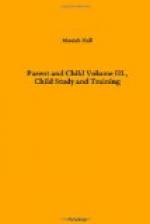In the preface of Dr. Guyer’s remarkable book, “Being Well Born,” we read the following: “It is no exaggeration to say that during the last fifteen years, we have made more progress in measuring the extent of inheritance and in determining its elemental factors than in all previous time.” If this is true, it would seem to be almost criminal for teachers and parents to neglect to acquaint themselves with the fundamental laws of heredity. This author says further: “Since what a child becomes is determined so largely by its inborn capacities, it is of the utmost importance that teachers and parents realize something of the nature of such aptitudes before they begin to awaken them. For education consists in large measure in supplying the stimuli necessary to set going these potentialities and of affording opportunity for their expression.”
Mendel’s law is probably the most important known principle of inheritance. Through its application practically all of the improvements in plants and animals have been brought about. This law may be explained as follows: A certain kind of pure bred fowl is found which is either pure white or black. If either color is mated with its own color the resulting progeny will be true to the color of the parents, but if a white and a black are crossed the result will be blue fowls possessing one-half the characteristics of each parent, but strange to say, if two blue fowls are mated the progeny will not be all blue, one-fourth will be white like one grandparent, another one-fourth black like the other grandparent, and one-half will be blue like the parents. If this experiment is repeated with plants and animals having opposite characteristics, the same ratios as above always result. This indicates that truly heritable traits or characters are separate units and are inherited independently. The breeder is thus enabled through selecting the traits or characters that are wanted and crossing them with a well-known stock, to produce almost any trait or quality that he desires. This law makes it possible to estimate the results of cross breeding with almost mathematical exactness. Improved varieties of fruits, grains and vegetables have been produced in this manner, and with animals marvelous results have been achieved.
Luther Burbank, in his little book, “The Training of the Human Plant,” says: “There is not a single desirable attribute which, lacking in a plant, may not be bred into it. Choose what improvement you wish in a flower, a fruit, or a tree, and by crossing, selection, cultivation and persistence, you can fix this desirable trait irrevocably.” And further: “If then we could have twelve families under ideal conditions where these principles could be carried out unswervingly, we could accomplish more for the race in ten generations than can now be accomplished in a hundred thousand years. Ten generations of human life should be ample to fix any desired attribute. This is absolutely clear, there is neither theory nor speculation.”




